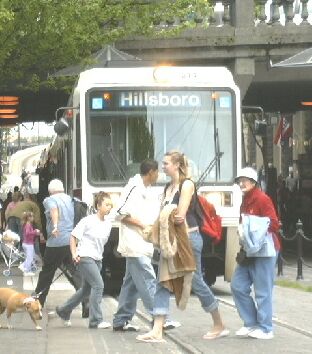
Light Rail Now! can be contacted at: Light Rail Now! |
Bill Becwar, of Wauwatosa, Wisconsin, is an engineer in computer medical imaging, as well as a historian and writer. He is also co-editor of a rail history publication, for which he likewise provides a news column. Rail critics persistently try to portray rail transit systems – especially light rail transit (LRT) operations – as unmitigated failures. But, even for dedicated Road Warriors, it's hard to ignore the spreading popularity of these new systems. So the critics' path of argument has shifted. A contention being heard more and more is that the undeniable increase in light rail projects being built in the US is merely the result of "federal pork" (i.e., extravagant luxuries of no real value). Highly successful LRT systems, like the one in Portland, Oregon, are favorite targets for this line of criticism. Recently, in an online discussion, the same "federal pork" explanation was presented in response to my question, "If this rail stuff is so unsuccessful, why has Portland continued to build more?" So much drivel has been spewed about this over the years, I decided to try to pin down the original base numbers to see just what is really happening. The table below shows the total costs and local allocations from the various federal grants and Federal Transit Administration (FTA) reports. MAX LRT Lines, Capital Costs, and Local Share
Now, let's look at some operating results – unit operating cost, number of vehicles, and riderhip on both bus and rail. These data are presented in the tables below. Operating Cost per Boarding Rider
Vehicles in Operation
Ridership (Average Daily Boardings)
Hmmm... So Portland's total local rail investment (so far) is about $512 million. But, stimulated by that investment is about $3.8 billion in new real estate investment within walking distance of a MAX rail station (defined as 1/4 mile). That would represent something like $76 million per year in property taxes alone (at 2%). By itself, this is a payback rate of about 7 years for the local investment – better than my high-efficiency furnace. From the tables above, we can see that one-seventh of the transit fleet on 4% of the routes carries about one-third of the entire transit ridership – and at 63% of the cost of a bus running in the same geographic territory. if you are paying tax support dollars either way, you'd save money by driving the buses into the Willamette Riverand putting the riders on rail.
These benefits of LRT don't seem to have been lost on Portland decision- makers. Two light rail lines and a second streetcar line are in the planning stages, set for openings in 2009, 2010, and 2014. More local bucks – and going to areas that rejected being part of the original rail transit plans way back when. And are Portland riders just being forced to crowd onto LRT because of a lousy, neglected bus service? Sorry to shoot down that developing theory, bus fans, but TriMet's buses are unusually clean, efficiently run, and economical – and fare-free over a large area of downtown. So there's no easy explanation from claiming that the rail looks unusually good there because the buses are crappy. San Diego also has comparable numbers – and there, the bus and rail systems are run by separate agencies. The MAX light rail in Portland carries 26% of all rush-hour commuters travelling in the Sunset Highway and Banfield Freeway corridors. Federal estimates are that this amounts to approximately 67,000 auto trips per day. Ridership has increased steadily for the last 17 years, and the new interstate Ave. (Yellow) line carries 95% more passengers than the bus line on the same street that it replaced. No wonder professional rail transit opponents like Randal O'Toole spend so much time trying to invent creative ways around these very numbers. And Portland is a fairly expensive place to build, with multiple rivers, valleys and tunnels. $512 million in local investment is a heckuva lotta dough, and they could easily have stopped at $36 million after building the first line if it really didn't work – or any time after that. Federal support has decreased somewhat over time, putting more demand on local resources – and Portland has responded. For example, the Airport line was paid for completely with local funding. OK, considering the suitably pedigreed numbers just presented, I repeat the issue at hand: The charge is that the light rail is a worthless and unrewarding idea that does nothing to improve traffic. if this is true, why do the cities that build light rail systems continue to build more? Still don't know? Look at the numbers again. Any way you look at them, the "federal pork" theory is pretty well roasted. Light Rail Now! website URL: http://www.lightrailnow.org/myths/m_por_2006-01a.htm Updated 2006/01/05 |
|||||||||||||||||||||||||||||||||||||||||||||||
|
|
||||||||||||||||||||||||||||||||||||||||||||||||